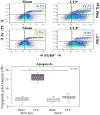invariant Natural Killer T Cells Modulate the Peritoneal Macrophage Response to Polymicrobial Sepsis
- PMID: 38824851
- PMCID: PMC11246799
- DOI: 10.1016/j.jss.2024.03.037
invariant Natural Killer T Cells Modulate the Peritoneal Macrophage Response to Polymicrobial Sepsis
Abstract
Introduction: A dysregulated immune system is a major driver of the mortality and long-term morbidity from sepsis. With respect to macrophages, it has been shown that phenotypic changes are critical to effector function in response to acute infections, including intra-abdominal sepsis. Invariant natural killer T cells (iNKT cells) have emerged as potential central regulators of the immune response to a variety of infectious insults. Specifically, various iNKT cell:macrophage interactions have been noted across a spectrum of diseases, including acute events such as sepsis. However, the potential for iNKT cells to affect peritoneal macrophages during an abdominal septic event is as yet unknown.
Methods: Cecal ligation and puncture (CLP) was performed in both wild type (WT) and invariant natural killer T cell knockout (iNKT-/-) mice. 24 h following CLP or sham operation, peritoneal macrophages were collected for analysis. Analysis of macrophage phenotype and function was undertaken to include analysis of bactericidal activity and cytokine or superoxide production.
Results: Within iNKT-/- mice, a greater degree of intraperitoneal macrophages in response to the sepsis was noted. Compared to WT mice, within iNKT-/- mice, CLP did induce an increase in CD86+ and CD206+, but no difference in CD11b+. Unlike WT mice, intra-abdominal sepsis within iNKT-/- mice induced an increase in Ly6C-int (5.2% versus 14.9%; P < 0.05) and a decrease in Ly6C-high on peritoneal macrophages. Unlike phagocytosis, iNKT cells did not affect macrophage bactericidal activity. Although iNKT cells did not affect interleukin-6 production, iNKT cells did affect IL-10 production and both nitrite and superoxide production from peritoneal macrophages.
Conclusions: The observations indicate that iNKT cells affect specific phenotypic and functional aspects of peritoneal macrophages during polymicrobial sepsis. Given that pharmacologic agents that affect iNKT cell functioning are currently in clinical trial, these findings may have the potential for translation to critically ill surgical patients with abdominal sepsis.
Keywords: Intra-abdominal sepsis; Invariant natural killer T cells; Peritoneal macrophages; Sepsis.
Copyright © 2024 Elsevier Inc. All rights reserved.
Conflict of interest statement
Figures









Similar articles
-
Systemic Inflammatory Response Syndrome.2025 Jun 20. In: StatPearls [Internet]. Treasure Island (FL): StatPearls Publishing; 2025 Jan–. 2025 Jun 20. In: StatPearls [Internet]. Treasure Island (FL): StatPearls Publishing; 2025 Jan–. PMID: 31613449 Free Books & Documents.
-
The Black Book of Psychotropic Dosing and Monitoring.Psychopharmacol Bull. 2024 Jul 8;54(3):8-59. Psychopharmacol Bull. 2024. PMID: 38993656 Free PMC article. Review.
-
Single-incision sling operations for urinary incontinence in women.Cochrane Database Syst Rev. 2017 Jul 26;7(7):CD008709. doi: 10.1002/14651858.CD008709.pub3. Cochrane Database Syst Rev. 2017. Update in: Cochrane Database Syst Rev. 2023 Oct 27;10:CD008709. doi: 10.1002/14651858.CD008709.pub4. PMID: 28746980 Free PMC article. Updated.
-
Single-incision sling operations for urinary incontinence in women.Cochrane Database Syst Rev. 2014 Jun 1;(6):CD008709. doi: 10.1002/14651858.CD008709.pub2. Cochrane Database Syst Rev. 2014. Update in: Cochrane Database Syst Rev. 2017 Jul 26;7:CD008709. doi: 10.1002/14651858.CD008709.pub3. PMID: 24880654 Updated.
-
Sepsis leads to lasting changes in phenotype and function of memory CD8 T cells.Elife. 2021 Oct 15;10:e70989. doi: 10.7554/eLife.70989. Elife. 2021. PMID: 34652273 Free PMC article.
References
-
- Thakkar R, Huang X, Lomas-Neira J, Heffernan D, Ayala A. Sepsis and the immune response. In: Eremin O, Sewell H, editors. Essential immunology for surgeons. Oxford: Oxford University Press; 2011. p. 303–42.
MeSH terms
Substances
Grants and funding
LinkOut - more resources
Full Text Sources
Medical
Research Materials
Miscellaneous

